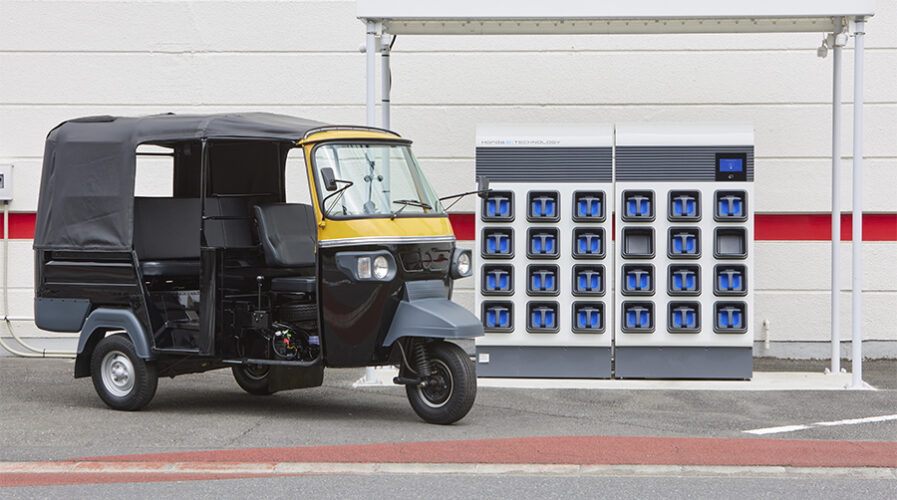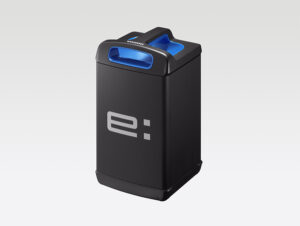Honda MPP, the battery created thanks to the Japanese consortium for electric motorcycles

Honda MPP
On March 26th, the 4 largest Japanese motorcycle manufacturers formed a consortium that will lead them to develop a system of interchangeable batteries for the electric models of the future: this means creating batteries with the same dimensions, the same weight. and the same technical specifications. Doing so can drastically reduce the time required for development, and the costs related to actual production, offering customers a technology that is already very flexible and compatible from the start. Obviously, to ensure that this system works and is efficient, it will be necessary to create an infrastructure of battery change and recharging stations.Of the 4 great Japanese, to date Yamaha and Suzuki have already unveiled a preview its electric models equipped with interchangeable batteries, but the real leader of the initiative is undoubtedly Honda: it is precisely the latter that has just unveiled the MPP - Mobile Power Pack, a battery that it expects to be able to integrate on some electric models 3-wheeler available on the Indian market within the first 6 months of 2022. Compared to the first generation MPP developed by Honda, this new version has a thinner design, a higher cell density and a heat dissipation system more efficient.
Obviously the other 3, Yamaha, Suzuki and Kawasaki will be able to propose their own technical solution, but it will have to respect the dimensional standards set with the Honda MPP: if res Since within the defined standard it will be possible to produce a battery capable of ensuring greater autonomy, the other participants in the consortium will have to adopt the technology on their electric motorcycles.
Honda's batteries will undoubtedly arrive on the market before those of the competition, but when other proposals are also available, customers will end up using the various batteries almost indistinctly, which is the ultimate goal in creating the consortium itself . Similar to what happens in Japan, Honda has entered into another international agreement with Yamaha, Piaggio and KTM, so it is quite likely that Honda's standard will soon become a world standard.
Honda to enable battery sharing for electric tricycles in India

Honda to offer battery sharing services for rickshaws in India. (source – Honda)
India is home to about 1.5 million battery-powered, three-wheeled electric tricycles or rickshaws on its roads. The subcontinent is also seeing about 11,000 news ones hit the streets almost every month, in a market worth around US$ 1.5 billion.
As the Indian economy continues to grow, energy demand is increasing and air pollution is worsening. To address these issues, country-wide efforts are being made to expand the utilization of renewable energy and to actively pursue electrification of the transportation sector, which accounts for approximately 20% of the nation’s greenhouse gas emissions.
There are currently more than eight million units of auto-rickshaws in India, which are mainly powered by CNG (compressed natural gas) in urban areas and have been a key challenge for electrification. Some states in India are hoping to rely fully on an electric public transport system by the end of the decade.
The country is already experimenting with e-Mobility for public transport and has even deployed electric inter-city buses across some major cities. In addition, state governments are also playing an active role in the deployment of policies encouraging the usage of electric vehicles.
For instance, Kerala aims to put one million electric vehicles on the road by 2022 and 6,000 e-buses in public transport by 2025. The state of Telangana aims to have electric vehicles sales targets for 2025 to achieve 80%. This does not only include private cars but also motorcycles, scooters, and auto-rickshaws.
Despite the increased adoption of electric tricycles, there is still a shortage of charging stations. As of 2017, the subcontinent only has 425 charging stations. The plan is to build 2800 stations by 2022.
But the reality is, electrified mobility products have issues of long-range travel, long charging times, and high costs of batteries. In fact, Tata plans to launch electric cars with a larger battery pack than its existing models.
Is battery sharing the answer for electric tricycles?For electric tricycles, Honda has plans to begin a battery-sharing service for electric tricycles in India in the first half of 2022. The rickshaws will be using Honda’s Mobile Power Pack e: (MPP), a new all-portable and swappable battery. Honda will work to eliminate the issues through the use of swappable batteries and by sharing such batteries.

(source honda)
As such, Honda began demonstration testing for battery sharing on electric tricycles in India in February 2021, with 30 units of electric rickshaw taxis driven for a total of more than 200,000 km in operation. Through this testing, Honda identified issues to be addressed and verified business viability.
The MPP is a portable and swappable lithium-ion battery capable of storing a large amount of electricity, more than 1.3kWh, which is an increase from the previous version of the MPP. It also features a body and handles designs reflecting the thorough pursuit of user-friendliness and excellence in handling by incorporating user feedback Honda obtained through demonstration testing.
The key features of the battery include high versatility, meaning it can be utilized as a power source for a broad range of compatible devices. It also has high durability from heat dissipation, deterioration due to high temperature, sufficient water resistance, vibration resistance, and shock resistance under the expected normal operating environment.
The built-in control unit also recognizes the conditions of the MPP and records the occurrence of all events. This data will be collected through the connector while MPP is charging and then utilized for the battery sharing operation and other secondary uses.
Battery sharing to solve battery woes?Honda’s battery sharing service will enable rickshaw drivers to stop by at the nearest battery swapping stations being set up in the city and swap an MPP with a low remaining charge for a fully charged MPP. The use of this service will significantly reduce driver concern about running out of batteries as well as the risk of losing business opportunities with customers while waiting for rickshaw batteries to be charged.
Minoru Kato, Chief Officer, Life Creation Operations, Honda Motor Co believes MPP has huge potential to electrify all kinds of devices, including small-sized mobility products, and expand the use of renewable energy.
“By offering a battery sharing service in India, Honda will contribute to the accelerated electrification of rickshaws and expanded use of renewable energy. Moreover, Honda will continue serving people worldwide with the joy of expanding their life’s potential by further expanding the utilization of the MPP into broader areas,” said Minoru.
The company will establish a local subsidiary in India to conduct a battery-sharing service business. The subsidiary will install several Honda Mobile Power Pack Exchanger e: as battery swapping stations and conduct battery sharing services in the city. Honda will work with electric rickshaw manufacturers and begin the service in selected cities first and then expand to other areas in stages.
While the idea of battery sharing within electric tricycles seems possible, the same process unfortunately may not work for energy vehicles. This is because energy vehicles use much larger batteries and take longer to charge as well. There has been some success in the creation and usage of superchargers but it may be some time before electric vehicles can begin sharing batteries.
Aaron Raj
Aaron enjoys writing about enterprise technology in the region. He has attended and covered many local and international tech expos, events and forums, speaking to some of the biggest tech personalities in the industry. With over a decade of experience in the media, Aaron previously worked on politics, business, sports and entertainment news.